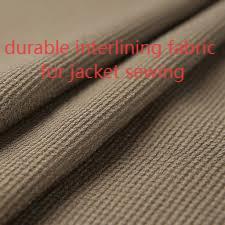In today’s apparel industry, a strategic internal layer can make or break garment quality; smart manufacturers integrate Interlining to maintain structure, improve fit, and enhance durability, ensuring that each piece meets consumer expectations. Proper placement and material selection of Interlining elevate the look and longevity of clothing, bridging design and functionality effectively.
1. Structural Integrity And Design Considerations
Garments rely on internal reinforcement to preserve shape under stress. Collars, cuffs, lapels, and waistbands benefit from targeted support, which prevents deformation and maintains clean lines. Designers must balance rigidity and flexibility, ensuring garments retain their intended silhouette without compromising comfort. The choice of thickness, density, and flexibility of this hidden layer is critical to achieving desired aesthetics.
2. Material Selection And Performance
Selecting the correct substrate is essential for functional performance. Natural fibers offer softness and breathability, while synthetic fibers provide tensile strength and resilience. Hybrid blends combine the advantages of both, allowing garments to remain stable, comfortable, and resistant to wear. Testing compatibility with outer fabrics and laundering processes ensures that reinforcement layers deliver consistent results without unwanted shrinkage or stiffness.
3. Production Techniques With Interlining-Factory
Advanced methods, such as fusible adhesives, sew-in layers, and coating technologies, optimize efficiency and consistency. Interlining-Factory employs digital precision for adhesive application, temperature-controlled pressing, and quality monitoring to reduce defects. Automated systems, combined with trained operators, ensure uniform thickness and adhesion, minimizing batch variation and maintaining the garment’s visual and tactile appeal.
4. Testing And Quality Assurance
Laboratory and real-world testing are both critical to predict performance. Simulated wash cycles, abrasion, and pressing trials detect potential delamination, stiffness, or color transfer. Establishing clear quality standards, documenting results, and implementing feedback loops allow manufacturers to fine-tune production parameters. This rigorous approach reduces defects, protects brand reputation, and guarantees consistent garment performance across production runs.
5. Sustainability And Future Practices
Environmental responsibility drives innovation in modern textiles. Lower-temperature bonding techniques, water-based adhesives, and recycled fibers reduce ecological impact. Designing for repairability, reuse, and recycling extends garment life and aligns with circular economy principles. Forward-looking manufacturers integrate these considerations into every stage, from material sourcing to end-of-life planning, ensuring durable, eco-conscious apparel. For more detailed insights, visit https://www.interlining-factory.com/news/what-is-interlining-types-applications-and-more.html
